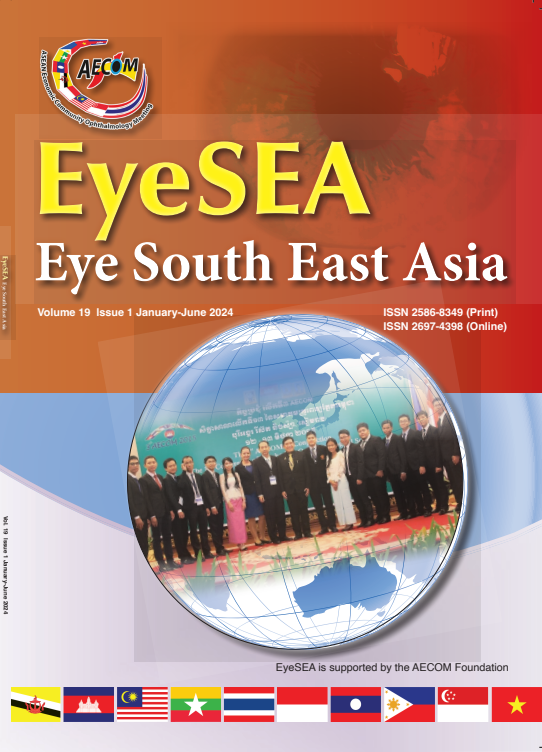Reliability and Validity of the Thai Version – The Standardized Patient Evaluation of Eye Dryness (T-SPEED)
Main Article Content
Abstract
Objective: To evaluate the reliability and validity of the Thai version of The Standardized Patient Evaluation of Eye Dryness questionnaire (T-SPEED)
Design: Cross-sectional descriptive study
Methods: Consisting of four steps
1) Translation of the SPEED questionnaire from English to Thai by a team consisting of an ophthalmologist and a linguist, subsequently reverse-translated from Thai to English by a separate team.
2) Content and construct validity of the translated questionnaire were evaluated by a group of ten experts.
3) Reliability of the translated questionnaire was evaluated from responses of 290 volunteers aged between 18 and 80 years of age, via Google Forms. The period allowed for response was from the 1st August 2022-31st January 2023.
4) Data analysis and evaluation of reliability and validity using item analysis and Cronbach’s Alpha Coefficient.
Results: The indexes of item-objective congruence (IOC) with a mean of 0.93. Content Validity Index scores (CVI) with a mean of 0.98. Item-level Content Validity Index (I-CVI) scores ranged between 0.9 and 1.0 with a total scale-level Content Validity Index (S-CVI) of 0.99. Data suggests this questionnaire has credible validity in both congruence and content. In addition, the data also suggests that the questionnaire has a statistically significant reliability. The group of four questions regarding frequency and regarding severity of eye dryness had a Cronbach Alpha Coefficient value of 0.775 and 0.837 respectively, which may be interpreted as credible.
Conclusion: The Thai-translated version of the SPEED questionnaire has both credible validity and reliability and can be applied to the Thai population and may be particularly beneficial in screening and follow-up of Thai patients with dry eye disease.
Article Details

This work is licensed under a Creative Commons Attribution-NonCommercial-NoDerivatives 4.0 International License.
References
Bhavsar AS, Bhavsar SG,Jain SM. A review on recent advances in dry eye: Pathogenesis and management. Oman J Ophthalmol. 2011;4(2):50-6.
O’Brien PD, Collum LM. Dry eye: Diagnosis and current treatment strategies. Curr Allergy Asthma Rep. 2004;4:314-9.
Gao J, Schwalb TA, Addeo JV, Ghosn CR, Stern ME. The role of apoptosis in the pathogenesis of canine keratoconjunctivitis sicca: The effect of topical cyclosporine A therapy. Cornea. 1998;17:654-63.
Melissa LH, Michelle LH. Ophthalmic Disorders. In: Marie C, Barbara GW, Terry LS, Patrick MM, Jill MK, Joseph TD. editors. Pharmacotherapy Principles and Practice.3rd Ed. McGraw-Hill. 2013:4892-993.
American Academy of Ophthalmology. Mechanisms of Dry Eye. In 2020-2021 BCSC (Basic and Clinical Science), Section 08:External Disease and cornea. San Francisco: American Academy of Ophthalmology. 2021:57-59.
The Definition and classification of dry eye disease: Report of the Definition and Classification Subcommittee of the International Dry Eye Workshop (2007). Ocul Surf. 2007;5:75-92.
Gao J, Schwalb TA, Addeo JV, Ghosn CR, Stern ME. The role of apoptosis in the pathogenesis of canine keratoconjunctivitis sicca: The effect of topical cyclosporine A therapy. Cornea. 1998;17:654-63.
Kunert KS, Tisdale AS, Stern ME, Smith IK. Analysis of topical cyclosporine treatment of patients with dry eye syndrome: Effect on conjunctival lymphocytes. Arch Ophthalmol. 2000;118:1489-96.
Stern ME, Gao J, Schwalb TA, Ngo M, Tieu DD, Chan CC, et al. Conjunctival T-cell subpopulations in Sjögren’s and non-Sjörgen’s patients with dry eye. Invest Ophthalmol Vis Sci. 2002;43:2609-14.
The epidemiology of dry eye disease: Report of the Epidemiology Subcommittee of the International Dry Eye Workshop (2007). Ocul Surf. 2007;5:93-107.
Lambert DW, Foster CS, Perry HD. Schirmer test after topical anesthesia and tear meniscus height in normal eyes. Arch Ophthalmol. 1979;97:1082-5.
Ang RT, Dartt DA, Tsubota K. Dry eye after refractive surgery. Curr Opin Ophthalmol. 2001;12:318-22.
Blehm C, Vishnu S, Khattak A, Mitra S, Yee RW. Computer Vision syndrome: A review. Surv Ophthalmol. 2005;50:253-62.
Wolkoff P, Nojaard JK, Troiano P, Piccoli B. Eye Complaints in the office environment: Precorneal tear film integrity influenced by eye blinking efficiency. Occup Environ Med. 2005;62:4-12.
Management and therapy of dry eye disease: Report of the Management and therapy Subcommittee of the International Dry Eye WorkShop (2007). Ocul Surf. 2007;5:163-78.
American Academy of Ophthalmology. Mechanisms of Dry Eye. In 2020-2021 BCSC (Basic and Clinical Science Course), Section 08: External Disease and Cornea. San Francisco: American Academy of Ophthalmology. 2021:58.
Methodologies to diagnose and monitor dry eye disease: Report of the Diagnostic Methodology Subcommittee of the International Dry Eye WorkShop (2007). Ocul Surf. 2007;5:108-52.
Perry HD. Dry Eye Disease: Pathophysiology, classification, and diagnosis. Am J Manag Care. 2008;14(13 Suppl): S79-87.
Cintia S, DE Pavia, Pflugfelder Sc. Diagnostic approaches to lacrimal keratoconjunctivitis. In: Pflugfelder SC, editor. Dry eye and ocular surface disorders. New York: Marcel Dekker; 2004:270.
Perry HD, Donnenfeld ED. Dry eye diagnosis and management in 2004. Curr Opin Ophthalmol. 2004;15:299-304.
Finis D, Pischel N, Konig C, et al. Vergleich des NSDI-und SPEED-Fragebogens zur Evaluation des Sicca-Syndroms in der klinischen Praxis. Ophthalmology. 2014:111;1050-56.
Yuichi Okumusu, et al. A Series of Dry eye Questionnaires: Measuring PATIENT -outcomes and Health -Related Quality of Life. Diagnostic. Multidisciplinary Digital Publishing Institute (MDPI).
Asiedu K, Kyei S, Mensah SN, Ocansey S, Kyere EA. Ocular Surface Disease Index (OSDI) Versus the Standard Patient Evaluation of Eye Dryness (SPEED): A Study of a Nonclinical Sample. Cornea. 2016:35(2);175-180.
Ana Lucia Samches, et al. Adaptation of the Standardized Patient Evaluation of Eye Dryness Questionnaire to European Portuguese (SPEED-Vp) in a Non Clinical Sample. Acts Medics Portuguese.
Alessio Focchin, et al. Italian tarnation Validation and repeatability of Standard Patient Evaluation of Eye Dryness (SPEED) Questionnaire. Content Lena and Anterior Eye. 2022:45(5).
May M Bakkar, et al. Validation of Arabic Version of the Ocular Sundaes Disease Index Questionnaire. International Journal of Ophthalmology. 2021:14(10);1595-1601.
Beaton DE, et al. Guidelines you the process of Cross Cultural adaptation of self – report Measure. Spine. 2000;25:3186-91.


